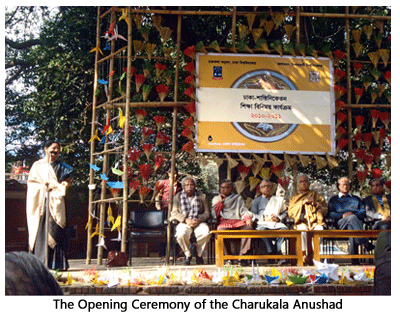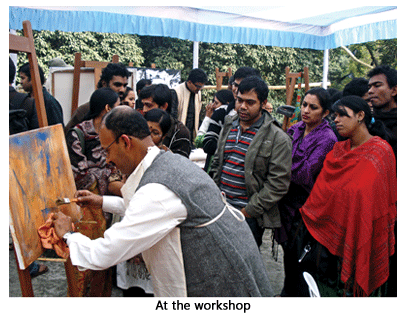- Prelude
- Editorial
- Subodh's 'return home'
- A Conversation with TV Santosh
- It's a War Out There
- Raqib Shaw
- Illusions in Red from a very British Indian Sculptor
- Stand Alone: Shibu Natesan
- Reading Atul Dodiya
- Bharti Kher: An Obsession for Bindis
- Bose Krishnamachari
- The Image - Spectacle and the Self
- From Self-depiction to Self-reference: Contemporary Indian Art
- GenNext: The Epitome of New Generation Art
- Kolkata's Contemporary Art A Look in the Mirror
- Innovation Coalesced with Continuing Chinese Qualities
- Kala Bhavana-Charukala Anushad Exchange Program
- Montblanc Fountain Pens
- Dutch Designs: The Queen Anne Style
- Bangalore Dance Beat
- Decade of change
- Distance Between Art & It's Connoisseur
- What Happened and What's Forthcoming
- 3rd India Art Summit
- New Paradigms of the Global Language of Art
- Black Brown & The Blue: Shuvaprasanna
- Art Events Kolkata
- Musings from Chennai
- Art Bengaluru
- Printmaker's Season
- Mumbai Art Sighting
- The Pause of Profound Stillness
- Previews
- In the News
- The Rebel Queen: An icon of her own times yet looked down upon
ART news & views
Kala Bhavana-Charukala Anushad Exchange Program
Volume: 3 Issue No: 14 Month: 3 Year: 2011
Report
by Dr Sanjoy Mallik

Academic institutions are ideally expected to be locations for the nurture of excellence and the site for exchange of ideas. Such exchange usually occurs throughout the academic calendar within and between its constituent members, in a manner that is best termed an 'internal' dialogue. However, periodically it becomes imperative to snap the rigour of predictable regularity through interaction with a peer community. One of the foremost measures in achieving this has been encounter with scholarly fraternity from other institutions. These “faculty exchange programs” introduce fresh ideas, concepts and differing points of view in perceiving the discipline. While it is certainly possible to encounter perceptions that run parallel to one's own, which boost and reassure through shared commonalities, it is the exhilaration of coming upon ones that run contrary or contrapuntal rhythm, that necessitates reviews, re-considerations and critical self-analysis. Either way, an 'exchange program' is a welcome phenomenon to the community.
In January 2011, Dhaka University, Bangladesh and Visva Bharati, Santiniketan converged together at the Charukala Anushad, the Faculty of Fine Arts at Dhaka, for a week-long workshop- seminar, with an aim to foster mutual sharing of visions and debate perceptual positions. A team of twelve faculty members from Kala Bhavana, Visva Bharati, reached Dhaka in the late evening of the 22nd January. This team comprised of Nanda Dulal Mukherjee, Dilip Kumar Mitra and Sanchayan Ghosh from the Department of Painting, Sumitabha Pal and Rishi Barua from the Department of Sculpture, Salil Sahani and Arpan Mukherjee from the Department of Printmaking, Prabir Kumar Biswas and Prasun Kanti Bhattacharya from the Department of Design, Sanjoy Kumar Mallik and team-coordinator Soumik Nandy Majumdar from the Department of History of Art, headed by Principal Pankaj Panwar (Department of Sculpture). The January trip was a corollary to an earlier visit by faculty members of the Charukala Anushad to Santiniketan in December 2010.
The inaugural ceremony was graced by distinguished members from both countries, including Prof Nazrul Islam, the Chairperson of the UGC, Bangladesh, Prof A A Siddiqi, the Vice Chancellor of Dhaka University, the renowned painter Qayyum Chowdhury, and Prof K G Subramanyan, Emeritus Professor from Kala Bhavana,  Visva Bharati. The dignitaries unanimously expressed their conviction in the fruitfulness of Bangladesh-India academic-cultural exchange.
Visva Bharati. The dignitaries unanimously expressed their conviction in the fruitfulness of Bangladesh-India academic-cultural exchange.
The workshop-camp jointly participated by the visiting faculty members of Kala Bhavana and the participating artists and faculty members of Dhaka drew steady attendance from the student community, who were keen to observe the diversity of personal languages, techniques and methods with inquisitive absorption. It was heartening to find them interacting with the visiting participants, because it is such an interaction that is at the heart of the intention of an exchange program.
The post-lunch seminar-presentations equally drew a full-house attendance, with a range of themes being addressed, from a re-evaluation of the early modernist contributions of Nandalal Bose, Ramkinkar Baij and Rabindranath Tagore, the survey of folk art practices in Bangladesh, characteristics of the mainstream art trends in Bangladesh, and the spectrum of alternative art-practices and new media at Santiniketan. The presentations were made by Nisar Hussain, Lala Rukh Selim, Soumik Nandy Majumdar, Sanjoy Mallik and Sanchayan Ghosh. It was possible to gauge the interest that these papers had generated among the audience from the interventions and observations following each presentation.
The interaction between the visiting participants and the art-community of Dhaka did not remain restricted to the academic ambience of the University alone. Evening gatherings at the Bengal Foundation, the Gallery Chitrak, the Cosmos-Atelier 71 and the Dhaka Art Centre brought the Kala Bhavana faculty members into direct contact with the larger art-community in the city. Similarly, it was enlightening to meet representatives from Depart and Shilparup, an experience that provided a glimpse into the practice of art-history/art-criticism through the respective art-journals.
It would have been customary to end this report on the note of its success, the fact that Prof A H M Matlub Ali, the present Dean of the Faculty, had surprised us through his uninterrupted accessibility, that Prof Farida Zaman and Prof Nisar Hussain had been untiring in their efforts at successful coordination of the entire program or the fact that the entire  faculty at Charukala Anushad need to be applauded for the success of the exchange. However, a couple of personal observations certainly need to go on record beyond these predictables. The very proposition of a visit to Dhaka had sparked off an emotional interest among those participants from Kala Bhavana who recall not-so-distant pre-partition familial roots in the eastern provinces of an erstwhile undivided Bengal. Unfortunately, both my paternal and maternal roots are securely deep in West Bengal, so that I tended to miss the specific dimension of this nostalgia in a shared memory. Therefore from my unfortunate vantage point of an “outsider” I had been on the lookout for possible links between the two Bengal-s, as well as an equal possibility of identifying differences that go deeper beneath the obvious surface. The frequent refrain that still rings in my ears are the apparently contradictory utterance of amazement among the visiting members right from the moment of crossing the border at Benapole on the one hand “look how similar” and on the other “see I told you it's not the same back home”. It is an infinite advantage for a nation to be strung together by one single language; it is another experience to be part of a multi-lingual nation that nevertheless finds it possible to hold together despite odds.
faculty at Charukala Anushad need to be applauded for the success of the exchange. However, a couple of personal observations certainly need to go on record beyond these predictables. The very proposition of a visit to Dhaka had sparked off an emotional interest among those participants from Kala Bhavana who recall not-so-distant pre-partition familial roots in the eastern provinces of an erstwhile undivided Bengal. Unfortunately, both my paternal and maternal roots are securely deep in West Bengal, so that I tended to miss the specific dimension of this nostalgia in a shared memory. Therefore from my unfortunate vantage point of an “outsider” I had been on the lookout for possible links between the two Bengal-s, as well as an equal possibility of identifying differences that go deeper beneath the obvious surface. The frequent refrain that still rings in my ears are the apparently contradictory utterance of amazement among the visiting members right from the moment of crossing the border at Benapole on the one hand “look how similar” and on the other “see I told you it's not the same back home”. It is an infinite advantage for a nation to be strung together by one single language; it is another experience to be part of a multi-lingual nation that nevertheless finds it possible to hold together despite odds.
The “gain” from the Dhaka trip was not merely restricted to the first hand art-historical delight in the opportunity to visit the Salban Vihara at Mainamati, or the walk down the lanes of history at the Panam City of Sonargaon, neither was it the overwhelming surprise at the hospitality of the daily dinner- dawat-s. It was infinitely deeper. It was the regeneration of an inner reflection on the historic factors behind the calamitous split between a linguistic community that now positions the Bengali into the split identities of two different nations, their common yet distinct aspirations, dreams and lived realities.